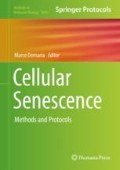Abstract
Cellular senescence is a permanent growth arrest mechanism triggered by various forms of stress. Senescent cells accumulate in the mammalian organism with age and are present at sites of tissue damage and age related pathologies. However, the characterization of senescence cells in vivo is currently limited and the need for new technologies to detect and monitor the senescence state in vivo has greatly increased. Here we demonstrate the use of the ImageStreamX as a powerful method for detection and quantification of senescent cells at distinct tissues and cell subpopulations. The identification of senescent cells using ImageStreamX enables the use of a combination of several senescence-related markers, together with the commonly used senescence-associated beta-galactosidase assay. These can be combined with the use of other molecular features typical of senescence cells, such as the γH2AX foci, indicating the activation of DNA damage response. This novel method offers a feasible solution to quantify senescent cells in vivo, in a comprehensive manner. Such quantification is necessary in order to understand the role of cellular senescence in aging and disease.
Access this chapter
Tax calculation will be finalised at checkout
Purchases are for personal use only
References
Campisi J (2013) Aging, cellular senescence, and cancer. Annu Rev Physiol 75:685–705. https://doi.org/10.1146/annurev-physiol-030212-183653
Munoz-Espin D, Serrano M (2014) Cellular senescence: from physiology to pathology. Nat Rev Mol Cell Biol 15:482–496. https://doi.org/10.1038/nrm3823
Burton DG, Krizhanovsky V (2014) Physiological and pathological consequences of cellular senescence. Cell Mol Life Sci 71:4373–4386. https://doi.org/10.1007/s00018-014-1691-3
He S, Sharpless NE (2017) Senescence in health and disease. Cell 169:1000–1011. https://doi.org/10.1016/j.cell.2017.05.015
Ovadya Y, Krizhanovsky V (2014) Senescent cells: SASPected drivers of age-related pathologies. Biogerontology 15:627–642. https://doi.org/10.1007/s10522-014-9529-9
Chuprin A, Gal H, Biron-Shental T, Biran A, Amiel A, Rozenblatt S, Krizhanovsky V (2013) Cell fusion induced by ERVWE1 or measles virus causes cellular senescence. Genes Dev 27:2356–2366. https://doi.org/10.1101/gad.227512.113
Sagiv A, Burton DG, Moshayev Z, Vadai E, Wensveen F, Ben-Dor S, Golani O, Polic B, Krizhanovsky V (2016) NKG2D ligands mediate immunosurveillance of senescent cells. Aging (Albany NY) 8:328–344. https://doi.org/10.18632/aging.100897
Biran A, Perelmutter M, Gal H, Burton DG, Ovadya Y, Vadai E, Geiger T, Krizhanovsky V (2015) Senescent cells communicate via intercellular protein transfer. Genes Dev 29:791–802. https://doi.org/10.1101/gad.259341.115
Sagiv A, Biran A, Yon M, Simon J, Lowe SW, Krizhanovsky V (2013) Granule exocytosis mediates immune surveillance of senescent cells. Oncogene 32:1971–1977. https://doi.org/10.1038/Onc.2012.206
Hoenicke L, Zender L (2012) Immune surveillance of senescent cells—biological significance in cancer- and non-cancer pathologies. Carcinogenesis 33:1123–1126. https://doi.org/10.1093/carcin/bgs124
Debacq-Chainiaux F, Erusalimsky JD, Campisi J, Toussaint O (2009) Protocols to detect senescence-associated beta-galactosidase (SA-betagal) activity, a biomarker of senescent cells in culture and in vivo. Nat Protoc 4:1798–1806. https://doi.org/10.1038/nprot.2009.191
Dimri GP, Lee X, Basile G, Acosta M, Scott G, Roskelley C, Medrano EE, Linskens M, Rubelj I, Pereira-Smith O, Peacocke M, Campisi J (1995) A biomarker that identifies senescent human cells in culture and in aging skin in vivo. Proc Natl Acad Sci U S A 92:9363–9367
Davalos AR, Kawahara M, Malhotra GK, Schaum N, Huang J, Ved U, Beausejour CM, Coppe JP, Rodier F, Campisi J (2013) p53-dependent release of Alarmin HMGB1 is a central mediator of senescent phenotypes. J Cell Biol 201:613–629. https://doi.org/10.1083/jcb.201206006
Biran A, Zada L, Abou Karam P, Vadai E, Roitman L, Ovadya Y, Porat Z, Krizhanovsky V (2017) Quantitative identification of senescent cells in aging and disease. Aging Cell 16:661–671. https://doi.org/10.1111/acel.12592
Acknowledgment
This work was supported by grants to V.K. from the European Research Council under the European Union’s FP7 and from the Israel Science Foundation; and staff scientist internal grant from the Weizmann Institute of Science to Z.P. V.K. is an incumbent of the Karl and Frances Korn Career Development Chair in Life Sciences.
Author information
Authors and Affiliations
Corresponding author
Editor information
Editors and Affiliations
Rights and permissions
Copyright information
© 2019 Springer Science+Business Media, LLC, part of Springer Nature
About this protocol
Cite this protocol
Gal, H., Porat, Z., Krizhanovsky, V. (2019). A Multiparametric Assay to Evaluate Senescent Cells. In: Demaria, M. (eds) Cellular Senescence. Methods in Molecular Biology, vol 1896. Humana Press, New York, NY. https://doi.org/10.1007/978-1-4939-8931-7_11
Download citation
DOI: https://doi.org/10.1007/978-1-4939-8931-7_11
Published:
Publisher Name: Humana Press, New York, NY
Print ISBN: 978-1-4939-8930-0
Online ISBN: 978-1-4939-8931-7
eBook Packages: Springer Protocols

